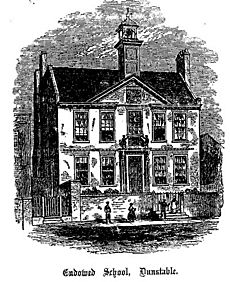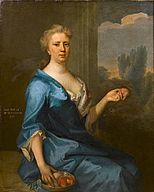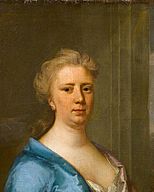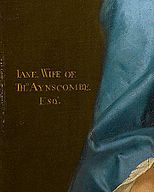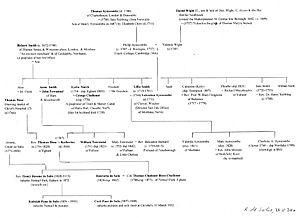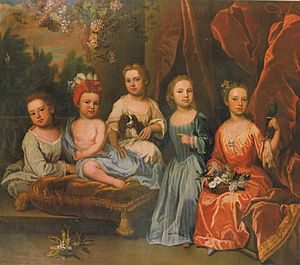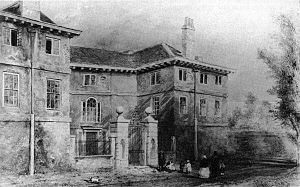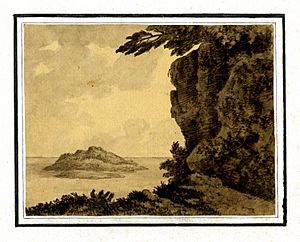Thomas Aynscombe facts for kids
Thomas Aynscombe was a landlord and a kind person who gave money to good causes in the early 1700s. He owned land and buildings in Dunstable and Smithfield, London.
Thomas Aynscombe (who died in October 1740) lived near Charterhouse Square and in Northall, Buckinghamshire. His father was Henry Aynscombe (who died in 1697), a London merchant. His mother was Elizabeth (who died in 1711), whose family, the Chews, were from Dunstable.
His mother, Elizabeth Chew, was one of three sisters who inherited a lot of money and property from their brother, William Chew. William Chew (who died in 1713) was a distiller from Dunstable. He had a large estate worth £28,000. This included properties in London and several famous coaching inns in Dunstable, like the Windmill and Still and the Sugar Loaf. He also owned many farms and manors (large estates) in different areas. William Chew was buried in Dunstable Priory.
William Chew's estate was passed down to his sisters, Frances and Jane, and to his nephew, Thomas Aynscombe. Thomas inherited his share because his mother, Elizabeth, had already passed away. These three family members then started Chew's Foundation in Dunstable, which was a school that opened in September 1724. The building for the school is still standing today and has their names on it.
Thomas Aynscombe's Family
Thomas Aynscombe married his first wife, Jane, in 1706. Jane was the daughter of Philip Stebbing, a grocer and important person in Norwich. Philip Stebbing was a Deputy Lieutenant for Norwich. He was also the Mayor of Norwich in 1687. He was known for being very strict with people who didn't follow the main church rules.
Philip Stebbing was buried in St Peter Mancroft church, along with his wife and three children. One of his sons, also named Philip Stebbing, died in 1715 and left his property to his brother-in-law, Thomas Aynscombe.
- Jane Stebbing (Studio of John Verelst)
Thomas Aynscombe also had a sister named Jane Elliott (who died in 1718). She lived near Charterhouse yard and left him money. She also gave £100 to Christ's Hospital and £10 to charity schools in London. She wanted to be buried near her father, but she was buried in St. Sepulchre instead. His other sister, Elizabeth Gilbert, was still alive in 1739.
Thomas Aynscombe's Will
Thomas Aynscombe wanted to be buried in the church of St Sepulchre. He asked for a nice monument to be built for him there, costing up to one hundred guineas. He also wanted £200 to be spent on his funeral. He asked that his tenants who paid him at least £10 a year in rent would receive a special ring worth twelve shillings.
Aynscombe was a supporter of several hospitals. He gave £200 each to Christ's Hospital and St. Bart's hospital. He also gave £20 to the charity school of St. Sepulchre. He is buried at St Sepulchre-without-Newgate.
His Granddaughter and Heirs
All of Thomas Aynscombe's sons, Philip, Thomas, and Chew, died before him.
His only granddaughter, Valentina (who died in 1771), was the only child of his son Philip. She inherited his property. Valentina married Lillie Smith (who died in 1791). As Thomas Aynscombe wished in his will, Lillie Smith changed his last name to Aynscombe in 1747.
Lillie Smith Aynscombe was a director of the Sun Fire Office, an insurance company, from at least 1754 until he died in 1791.
Around 1750, he bought and rebuilt a house called the Hermitage near Windsor. He lived there until 1773, when he sold it to the Duke of Gloucester. The Duke renamed it Sophia Farm. This area is now part of Legoland Windsor.
When Lillie Aynscombe died in 1791, a magazine reported that he had seven sisters. Their ages, along with his own, added up to 572 years!
He also had three daughters, but they all died without having children:
- Valentina Aynscombe (who died in 1841 at age 92) lived in Cromwell House, Mortlake. In 1828, she gave £100 to help start King's College, London.
- Mary Aynscombe (who died in 1828) married Reverend John Mossop.
- Charlotte Anne Aynscombe (who died in 1799) lived in Mortlake. It is believed that a famous drawing teacher, Alexander Cozens, taught her and her siblings.
A distant relative, Thomas-Chaloner Bisse-Challoner (1788-1872), eventually inherited the family's property.


